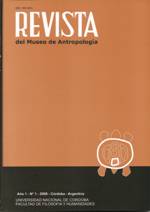In the shadow of Argentinean archaeology: Jorge von Hauenschild and the formation of the von Hauenschild collection at the Museo de Antropología (Universidad Nacional de Córdoba)
DOI:
https://doi.org/10.31048/1852.4826.v1.n0.5396Keywords:
history of collections, Jorge von Hauenschild, Santiago del Estero, Archaeology, Museo de AntropologíaAbstract
This is a study of the von Hauenschild collection located at the Museo de Antropología, Facultad de Filosofía y Humanidades of the Universidad Nacional de Córdoba, Argentina. The study is an exploration of the history of the collection through time and space and how it was formed and collected in the province of Santiago del Estero by the German born engineer, Jorge von Hauenschild between 1928 through 1951. The collection consists of over 4000 objects, the largest amount of elements in the collection is ceramics, but it also includes various lithic artifacts and human remains.
This paper is the result of the study of the von Hauenschild collection as a part of the Museo de Antropología, (UNC) plan of collection management which intends to revalorize it. From the perspective of collection management the objects in the collection is studied and through analysis of von Hauenschild’s personal archive; we step closer to understand the trajectory of a man that started out as an advocate, in our present perspective, to later transform into a self-thought archaeologist. The study also tries to demonstrate that von Hauenschild used modern methods, for the time, to investigate and reveal the native heritage of the province where he lived for over 30 years.
Downloads
References
Barringer, T.y T.Flynn. 1998. Colonialism and the Object: Empire, Material Culture and the Museum, Routledge, London and New York.
Bonnin, M. 2008. La conformación de colecciones en la construcción de las antropologías locales: El Instituto de Arqueología, Lingüística y Folklore de Córdoba (1941-48). Manuscrito en posesión del autor.
Fasth, N. 2003. «La Candelaria- Preservation and Conservation of an Archaeological museum Collection from North-Western Argentina at the Museum of World Culture, Sweden.» Department of Environmental Science and Conservation, Institute of Conservation, Göteborg University, Suecia. Tesis de Maestría inédita.
Ferreyra, C. A. 2006. Museo, Ciencia y Sociedad en la Córdoba moderna. El Museo Histórico Provincial y el Museo de Antropología: pensamiento y práctica. Publicaciones, Universidad Nacional de Córdoba.
von Hauenschild, J. 1943a. Revista de la Junta de Estudios Históricos de Santiago del Estero. Año I, N° 1. Santiago del Estero.
von Hauenschild, J. 1943b. Los Aborígenes de Santiago del Estero. En: Revista de la Junta de Estudios Históricos de Santiago del Estero, Año I, N° 2., pp: 116-137, Santiago del Estero.
von Hauenschild, J. 1949. Ensayo de clasificación de la documentación arqueológica de Santiago del Estero. Universidad Nacional de Córdoba. International Council of Museums (ICOM) 2006, Código de deontología del ICOM para los museos.
Lindberg, C. 1996. Erland Nordenskiöld- ett indianlif. Kungliga Vitterhets Akademins Serie: Svenska Lärde. Bokförlaget Natur & Kultur, Stockholm.
Lindskoug, H. B. 2008. «Mysteries from the inside of the earth, heritage hidden away in the depths of a deposit- A study in collection management of the von Hauenschild collection at the Museo de Antropología, UNC, Argentina.» Museion, Göteborg University, Suecia. Tesis de Maestría inédita. 77 paginas.
Martínez, A. T., C. Taboada y L. A. Auat. 2003. Los Hermanos Wagner: entre ciencia, mito y poesía. Arqueología, campo arqueológico nacional y construcción de identidad en Santiago del Estero 1920-1940. Ediciones Universidad Católica de Santiago del Estero. Santiago del Estero.
Miles, G. 1988. Conservation and Collection Management: Integration or Isolation. The International Journal of Museum Management and Curatorship 7: 159-163.
Mörner, M. 1985. Actividades políticas y económicas de los jesuitas en el Río de la Plata. Editorial Hyspamérica.
Mörner, M.1953. The political and economic activities of the Jesuits in the La Plata region. The Hapsburg Era. Library and Institute of IberoAmerican Studies, Stockholm.
Ocampo, B. 2005. La Nación Interior- Canal Feijóo, Di Lullo y los Hermanos Wagner- El Discurso culturalista de estos intelectuales en la provincia de Santiago del Estero. Antropofagia, Buenos Aires.
Pearce, S. 1997. Archaeology as collection. En: Representing Archaeology in Museums, G.T. Denford (editor), The Museum Archaeologist 22: 6-12.
Tilley, C. 1994. Interpreting material culture. En: Interpreting Objects and Collections. Susan M. Pearce (editor). Leicester Readers in Museum Studies. Routledge, London and New York, pp: 67-75.
Wagner, E. y D. Wagner. 1934. La Civilización Chaco-Santiagueña y sus correlaciones con las del Viejo y Nuevo Mundo. Tomo I, Buenos Aires.
Periódicos consultados: La Gaceta (San Miguel de Tucumán); Mundo (Santiago del Estero); La Nación (Buenos Aires); La Prensa (Buenos Aires); Critica (Buenos Aires); El Indio (Buenos Aires); El Liberal (Santiago del Estero); Mundo Argentino.
Downloads
Published
Issue
Section
License
Those authors who have publications with this Journalaccept the following terms:
a. Authors will retain their copyrights and guarantee the journal the right of first publication of their work, which will be simultaneously subject to the Creative Commons Attribution License (Licencia de reconocimiento de Creative Commons) that allows third parties to share the work as long as its author and his first publication in this journal.
b. Authors may adopt other non-exclusive licensing agreements for the distribution of the version of the published work (eg, deposit it in an institutional electronic file or publish it in a monographic volume) provided that the initial publication in this journal is indicated.
c. Authors are allowed and recommended to disseminate their work on the Internet (eg in institutional telematic archives or on their website) before and during the submission process, which can lead to interesting exchanges and increase citations of the published work. (See The Effect of Open Access - El efecto del acceso abierto)












